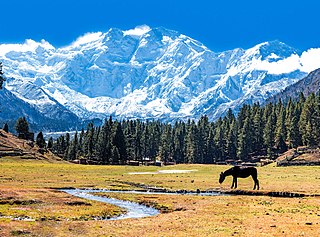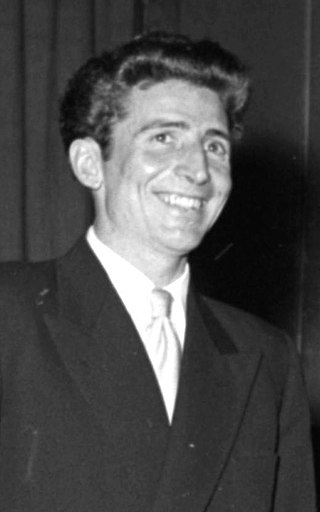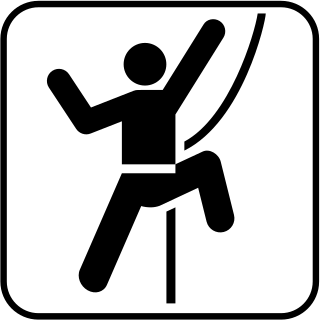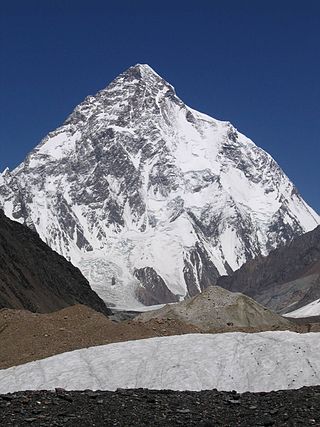
K2, at 8,611 metres (28,251 ft) above sea level, is the second-highest mountain on Earth, after Mount Everest. It lies in the Karakoram range, partially in the Gilgit-Baltistan region of Pakistan-administered Kashmir and partially in a China-administered territory of the Kashmir region included in the Taxkorgan Tajik Autonomous County of Xinjiang.

Mountaineering, mountain climbing, or alpinism, is a set of outdoor activities that involves ascending tall mountains. Mountaineering-related activities include traditional outdoor climbing, skiing, and traversing via ferratas. Indoor climbing, sport climbing, and bouldering are also considered variants of mountaineering by some.

Reinhold Andreas Messner is an Italian mountaineer, explorer, and author from South Tyrol. He made the first solo ascent of Mount Everest and, along with Peter Habeler, the first ascent of Everest without supplemental oxygen. He was the first climber to ascend all fourteen peaks over 8,000 metres (26,000 ft) above sea level without oxygen. Messner was the first to cross Antarctica and Greenland with neither snowmobiles nor dog sleds. He also crossed the Gobi Desert alone. He is widely considered one of the greatest mountaineers of all time.

Nanga Parbat, known locally as Diamer which means “king of the mountains”, is the ninth-highest mountain on Earth, its summit at 8,126 m (26,660 ft) above sea level. Lying immediately southeast of the northernmost bend of the Indus River in the Gilgit-Baltistan region of Pakistan-administered Kashmir, Nanga Parbat is the westernmost major peak of the Himalayas, and thus in the traditional view of the Himalayas as bounded by the Indus and Yarlung Tsangpo/Brahmaputra rivers, it is the western anchor of the entire mountain range.

Broad Peak is a mountain in the Karakoram on the border of Pakistan and China, the twelfth-highest mountain in the world at 8,051 metres (26,414 ft) above sea level. It was first ascended in June 1957 by Fritz Wintersteller, Marcus Schmuck, Kurt Diemberger, and Hermann Buhl of an Austrian expedition.

Hermann Buhl was an Austrian mountaineer. He was innovative in applying Alpine style to Himalayan climbing. His accomplishments include the first ascents of Nanga Parbat in 1953 and Broad Peak in 1957.

This glossary of climbing terms is a list of definitions of terms and jargon related to rock climbing and mountaineering. The specific terms used can vary considerably between different English-speaking countries; many of the phrases described here are particular to the United States and the United Kingdom.

The Kangshung Face or East Face is the eastern-facing side of Mount Everest, one of the Tibetan sides of the mountain. It is 3,350 metres (11,000 ft) from its base on the Kangshung Glacier to the summit. It is a broad face, topped on the right by the upper Northeast Ridge, and on the left by the Southeast Ridge and the South Col. Most of the upper part of the face is composed of hanging glaciers, while the lower part consists of steep rock buttresses with couloirs between them. The steep southern third of the Kangshung Face also comprises the Northeastern Face of Lhotse; this section may be considered a separate face altogether following the division of the South "Neverest" Buttress up to the South Col. It is considered to be a dangerous route of ascent, compared to the standard North Col and South Col routes, and it is the most remote face of the mountain, with a longer approach.

The 1953 American Karakoram expedition was a mountaineering expedition to K2, at 8,611 metres the second highest mountain on Earth. It was the fifth expedition to attempt K2, and the first since the Second World War. Led by Charles Houston, a mainly American team attempted the mountain's South-East Spur in a style which was unusually lightweight for the time. The team reached a high point of 7750 m, but were trapped by a storm in their high camp, where a team member, Art Gilkey, became seriously ill. A desperate retreat down the mountain followed, during which all but one of the climbers were nearly killed in a fall arrested by Pete Schoening, and Gilkey later died in an apparent avalanche. The expedition has been widely praised for the courage shown by the climbers in their attempt to save Gilkey, and for the team spirit and the bonds of friendship it fostered.

The 1924 British Mount Everest expedition was—after the 1922 British Mount Everest expedition—the 2nd expedition with the goal of achieving the first ascent of Mount Everest. After two summit attempts in which Edward Norton set a world altitude record of 28,126 feet (8572 m), the mountaineers George Mallory and Andrew "Sandy" Irvine disappeared on the third attempt. Their disappearance has given rise to the long-standing unanswered question of whether or not the pair climbed to the summit. Mallory's body was found in 1999 at 26,760 feet (8155 m), but the resulting clues did not provide conclusive evidence as to whether the summit was reached.

The 1922 British Mount Everest expedition was the first mountaineering expedition with the express aim of making the first ascent of Mount Everest. This was also the first expedition that attempted to climb Everest using bottled oxygen. The expedition would attempt to climb Everest from the northern side out of Tibet. At the time, Everest could not be attempted from the south out of Nepal, as the country was closed to Western foreigners.

Expedition style refers to mountaineering which involves setting up a fixed line of stocked camps on the mountain which can be accessed at one's leisure, as opposed to Alpine style where one carries all of one's food, shelter, equipment etc. as one climbs. Expedition style also incorporates the use of fixed ropes, and climbers will travel up and down the route several times to fix ropes and set up camps, while Alpine style eschews fixed ropes, porters, and camps, and climbers usually only climb the route once in a continuous push. Expedition style was the type of climbing Sir Edmund Hillary and Tenzing Norgay used in the first summitting of Mount Everest.

Amir Mehdi was a Pakistani mountaineer and porter known for being part of the team which managed the first successful ascent of Nanga Parbat in 1953, and of K2 in 1954 with an Italian expedition. He, along with the Italian mountaineer Walter Bonatti, are also known for having survived a night at the highest open bivouac - 8,100 metres (26,600 ft) - on K2 in 1954.

The 1975 British Mount Everest Southwest Face expedition was the first to successfully climb Mount Everest by ascending one of its faces. In the post-monsoon season Chris Bonington led the expedition which used rock climbing techniques to put fixed ropes up the face from the Western Cwm to just below the South Summit. A key aspect of the success of the climb was the scaling of the cliffs of the Rock Band at about 8,200 metres (27,000 ft) by Nick Estcourt and Tut Braithwaite. Two teams then climbed to the South Summit and followed the Southeast Ridge to the main summit – Dougal Haston with Doug Scott on 24 September 1975, who at the South Summit made the highest ever bivouac for that time, and Peter Boardman with Pertemba two days later. It is thought that Mick Burke fell to his death shortly after he had also reached the top. British climbers reached the summit of Everest for the first time in an event that has been described as "the apotheosis of the big, military-style expeditions".
The 1936 British Mount Everest expedition was a complete failure, and raised questions concerning the planning of such expeditions. This was Hugh Ruttledge's second expedition as leader. Heavy snows and an early monsoon forced their retreat on several occasions, and on the final attempt two climbers narrowly survived an avalanche. This was the first expedition in which climbers were able to carry portable radios.

The 1970 British Annapurna South Face expedition was a Himalayan climb that was the first to take a deliberately difficult route up the face of an 8,000-metre mountain. On 27 May 1970 Don Whillans and Dougal Haston reached the summit of Annapurna I which at 26,545 feet (8,091 m) is the highest peak in the Annapurna Massif in Nepal. Chris Bonington led the expedition which approached up a glacier from the Annapurna Sanctuary and then used rock climbing techniques to put fixed ropes up the steep South Face. Although the plan had been to use supplementary oxygen, in the event it was not possible to carry any cylinders high enough for the lead climbers to use on their summit bid.

The 1955 British Kangchenjunga expedition succeeded in climbing the 28,168-foot (8,586 m) Kangchenjunga, the third highest mountain in the world, for the first time. The expedition complied with a request from the Sikkim authorities that the summit should not be trodden on so the climbers deliberately stopped about five feet below the summit. George Band and Joe Brown reached the top on 25 May 1955, and they were followed the next day by Norman Hardie and Tony Streather. The expedition was led by Charles Evans who had been deputy leader on the 1953 British Mount Everest expedition.

On the 1953 German–Austrian Nanga Parbat expedition Hermann Buhl succeeded in making the first ascent of Nanga Parbat, the ninth highest mountain in the world. He reached the top on 3 July 1953 and this was and remains the only time an 8,000-metre summit was first reached by someone climbing alone. The expedition was led by Karl Herrligkoffer who went on to lead a long series of attempts to climb eight-thousanders in the Himalaya and Karakoram.

The 1979 Yugoslav Mount Everest expedition was the first successful summit of Mount Everest (8,848m) using the entire West Ridge route in the North Face of Everest. It was the seventh expedition in the Himalayas by the Yugoslav alpinist team, and their first ascent to the highest peak of Mount Everest. The route became known as the "Yugoslavian route" after the first successful ascent. The Yugoslav state leadership declared this ascent the greatest achievement of Yugoslav sports up to that time.

















